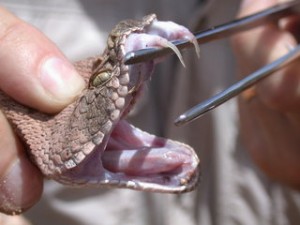Western Diamondback Rattlesnake
The western diamondback rattlesnake is a poisonous serpent found in many regions of the United States of America and Mexico. In fact, a large number of deaths caused by snake bites can be attributed to this species.
This rattlesnake has a heavy body and a triangular head, with two diagonal lines running through the sides of its face, from its eyes to the jaws. The snake gets its name from the diamond markings on its back. The tail has alternating bands of black and white a little above their characteristic rattles.
Scientific Classification
| Kingdom | Animalia |
| Phylum | Chordata |
| Subphylum | Vertebrata |
| Class | Reptilia |
| Order | Squamata |
| Suborder | Serpentes |
| Family | Viperidae |
| Subfamily | Crotalinae |
| Genus | Crotalus |
| Species | Crotalus Atrox |
Quick Information
| Other Popular Names | Western diamond-backed rattlesnake, adobe snake, Arizona diamond rattlesnake, coon tail, desert diamond back, desert diamond rattlesnake, fierce rattlesnake, spitting rattlesnake, Texan rattlesnake, Texas diamond back and Texas rattler |
| Size | 91 to 122 cm, can grow up to 224 cm |
| Weight | Up to 15 pounds |
| Color | Brown, gray, pink |
| Distribution | Texas, New Mexico, Arizona and California in USA and central parts of Mexico |
| Habitat | Deserts, forests, grassy plains, rocky hillsides and areas near coastlines |
| Sound | Rattles on the tail produce the characteristic rattling sound |
| Litter Size | Average – 14; Range-10 to 20 hatchlings |
| Gestation Period | 167 days |
| Lifespan | 22 years on average in captivity |
| Diet | Rats, gophers, lizards, mice, rabbits and ground-dwelling birds |
| Predators | Roadrunners, hawks, eagles, foxes, coyotes, kingsnakes and bobcats |
| IUCN Conservation Status | Least Concern |
Behavior
The western diamondback rattlesnake is mostly diurnal during spring and fall and nocturnal during summer. These snakes like to hunt in the night by ambushing prey as they fall in its trail, or even enter their burrows to attack them. They have the ability to swallow animals much larger than its size.
This rattlesnake likes to coil itself near the shade of bushes or cactus plants on pleasant days. When someone approaches the snake, it makes no movements so that it does not get detected. If this fails, it will assume a striking posture, give off its defensive warning rattle and try to go towards the nearest shelter. However, if it is threatened, it will defend its territory by assuming a fearsome stance and bite its intruder without hesitation.
As soon as autumn arrives, these reptiles go to their winter hibernacula or community dens, usually in a cave or rocky place. They may even use the burrows of prairie dogs as community dens in colder regions like prairie grasslands. Sometimes, it hibernates alone too, and this is common in warmer regions. They can go without food for several months by reducing their metabolism rates by up to 70 percent while growing longer at the same time.
Mating and Reproduction
The mating season takes place in the spring after these reptiles have emerged from hibernation.The male chases the female continuously during this time. If the paths of two males cross, they become engaged in a reptilian wrestling contest slamming each other’s bodies with rises and falls till one of them becomes exhausted and admits defeat.
This is followed by the victorious male crawling on top of the female who remains passive. The male continuously flicks its tongue and jerks the lower part of its body, putting its tail below the female’s tail. Then their cloacae come into contact with each other, resulting in copulation that lasts for several hours.
Life Cycle
These reptiles are ovoviviparous, meaning they bear their young live upon completion of the gestation period that lasts for 167 days. The birthing process takes around three to five hours and culminates with the young ones piercing the membranes of their eggs just before being born. The litter size ranges from 10 to 20 baby snakes.
These babies are armed with venom and fangs right from birth, making them very dangerous even at this tender age. Their mother stays with them only for a few hours or maximum for a day after which she abandons them, making them fend for themselves. Many of these babies die out as they are killed by predators while others starve to death on not being able to find food. Those snakes which survive become ready for breeding when they are three years of age.
Adaptations
These snakes are similar to other pit vipers and make use of heat sensing pits located between the eyes and nostrils to ascertain the presence of warm-blooded prey as well as predators. The venom of these snakes serves a dual function. Being highly toxic, it helps in killing their prey almost instantly. In addition to this, it also plays an important role in commencing the digestion of the internal organs of the larger animals they eat, within 24 hours of a meal.
Interesting Facts
- The name coon tail has come from the black markings with white patches in between on their tails.
- Rattlesnakes can move their rattles from front to back at the rate of more than 60 times per second.
- Rattlesnakes have the ability to attack with a venomous bite at a distance that is approximately two-thirds of their own length.
- Even though they are considered a danger to animals like deer, horse, antelope, and cow, these animals are a major threat to them as well, as they often trample on them in their natural habitat.
References:
- https://en.wikipedia.org/wiki/Crotalus_atrox
- http://www.desertusa.com/reptiles/western-diamondback-rattlesnake.html
- https://a-z-animals.com/animals/western-diamondback-rattlesnake/
- https://www.iucnredlist.org/species/64311/12763519
- http://animaldiversity.org/accounts/ Crotalus_atrox/
Published on July 21st 2015 by admin under Coniferous Forest Animals.
Article was last reviewed on 14th September 2023.











